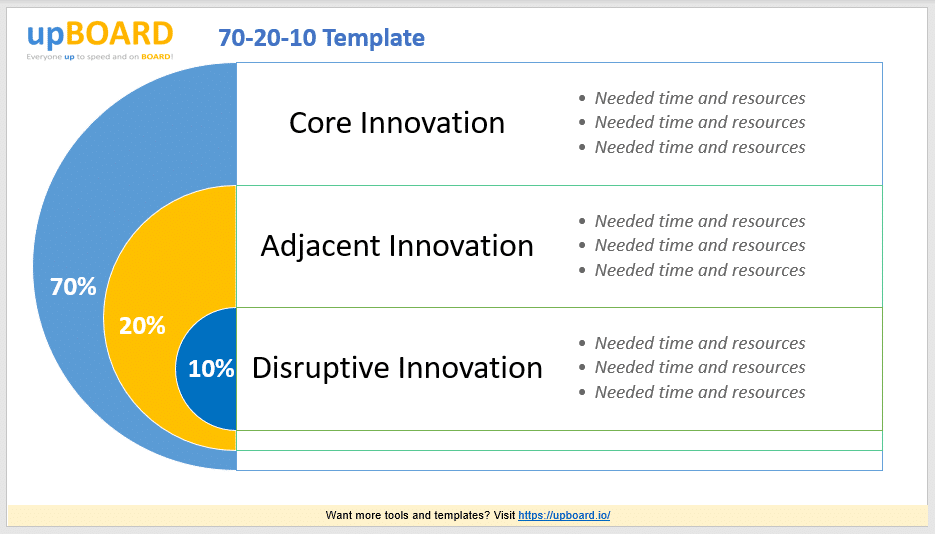How does your team allocate time to driving innovation within your business?
The 70-20-10 Rule is a strategy for determining how to allocate time and resources in order to make a successful innovation. Generally, the rule helps organizational stakeholders determine if they should make high risk/high reward innovations or improve upon existing products or services.
The basic idea behind the rule is that 70% of stakeholder time and organizational resources for innovation projects should be spent on core business, 20% on related projects to the core business and 10% of the time to projects unrelated to the core business but that can drive the organization forward.

Definition of the 70-20-10 Rule
The basic premise of the 70-20-10 Rule is that if the organizational stakeholders consistently makes small improvements to their existing line or enters into new markets, they will sustain the organization without ever evolving it to remain competitive with changing times. The allocation for time and resources indicated in the rule are really a suggestion and should not be rigidly adhered to. However, this framework has been proven helpful for successful innovation.
70%-Core Innovation
This section of rule stipulates that 70% of the organization’s core time and resources should be spent on bettering current products or services that have already been established to be well suited for furthering the organization’s core purpose. Said differently 70% of the resources should be used to improve or make more accessible things that have been proven to work well in the past. Core innovations should be well-integrated into the existing business model.
20%-Adjacent Innovation
This portion of the rule suggests that 20% of an organization’s time and resources should be spent producing innovations that are slightly adjacent to their core mission. For example, new or different markets could be explored or time and resources could be expended to develop products or services that are outside of the realm of what the company typically produces. Because these actions, products or services deviate from the norm, they are a riskier innovation with more potential to drive the company forward. However, less time and energy is devoted to them.
10%-Disruptive Innovation
The final portion of the rule proposes that 10% of the organizational stakeholder’s time and
resources should be allocated to breakthroughs that do not yet exist in the market. These innovations are often the riskiest because it unknown how the product or service will be received. However, they have the potential to bring high reward, as new technologies or methods of performing a service might transform the industry as it currently stands–existing methods become outdated and redundant. These innovations should be created separately from the core business.
Regardless of how the time and resources are allocated, successful core, adjacent and disruptive innovations requires able talent with diverse backgrounds. Further, core and adjacent innovations might progress more linearly whereas disruptive innovations might go through several non-linear stages as it is difficult to come up with a simple product for creating something that does not yet exist. Thus, it is critical to ensure the correct performance indicators are used for each type of innovation.
I helped create a 70-20-10 tool we use at Praxie, and that we make freely available as a download. It’s simple and is based on best practices I’ve gathered in the 3 decades I’ve spent as a strategic business consultant.
About the Author

Soren Kaplan is the bestselling and award winning author of Leapfrogging and The Invisible Advantage, an Affiliate at the Center for Effective Organizations at USC’s Marshall School of Business, a columnist for Inc. Magazine, a globally recognized keynote speaker, and the Founder of Praxie. Business Insider and the Thinkers50 have named him one of the world’s top management thought leaders and consultants.







